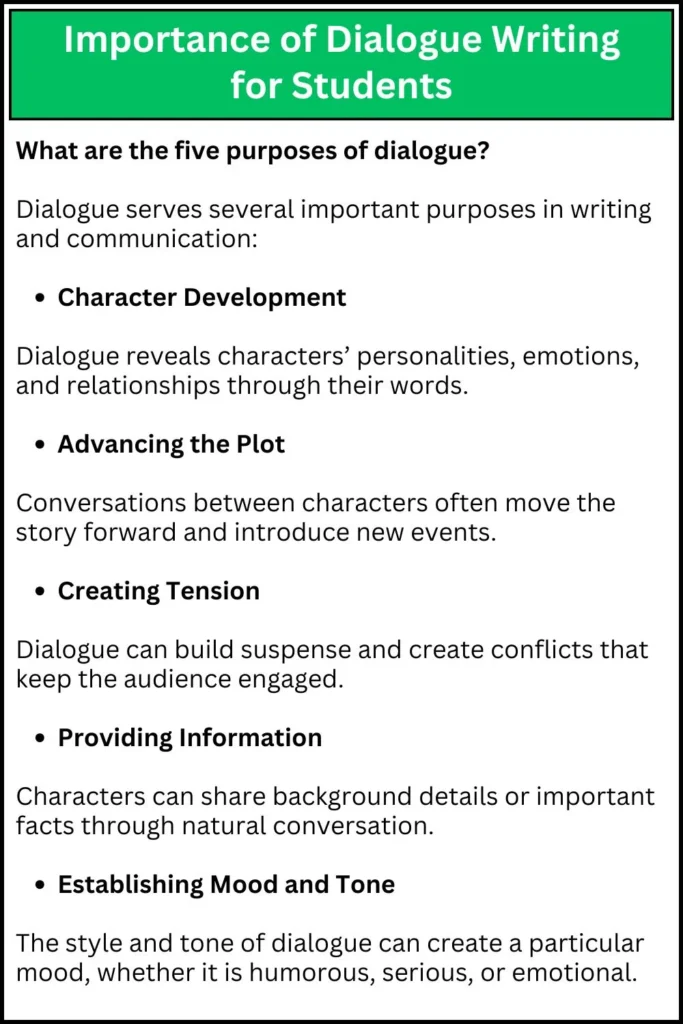Dialogue writing is a powerful skill that students need to develop to enhance their communication, creativity, and understanding of language. The importance of dialogue writing lies in its ability to teach students how to express ideas naturally and clearly. Through dialogue, learners can simulate real-life conversations, sharpen their thinking, and improve their storytelling abilities.
In this article, we will explore dialogue writing in depth and see why it holds a special place in the journey of English learners.
What is Dialogue Writing?
Dialogue writing is the art of capturing a conversation between two or more characters. In writing, a dialogue is usually presented within quotation marks and reflects how people speak in real life. Good dialogue shows character emotions, intentions, and relationships without directly stating them. It can make stories vivid, bring characters to life, and engage readers by making scenes more realistic and dynamic.
Why is Dialogue Important for Students?
Learning dialogue writing offers students many advantages. It helps students think critically about communication and language structure. When students write dialogue, they learn:
-
How to write naturally, using everyday language
-
How to develop characters and move a story forward
-
How to express emotions, thoughts, and reactions subtly
-
How to distinguish between formal and informal language
-
How to structure conversations logically
Practicing dialogue also improves speaking and listening skills, which are essential for effective communication in academic and real-world settings.

What are the five purposes of dialogue?
Dialogue serves several important purposes in writing and communication:
-
Character Development
Dialogue reveals characters’ personalities, emotions, and relationships through their words. -
Advancing the Plot
Conversations between characters often move the story forward and introduce new events. -
Creating Tension
Dialogue can build suspense and create conflicts that keep the audience engaged. -
Providing Information
Characters can share background details or important facts through natural conversation. -
Establishing Mood and Tone
The style and tone of dialogue can create a particular mood, whether it is humorous, serious, or emotional.
Types of Dialogue
Dialogue can take different forms depending on its purpose and structure. Some common types include:
-
Inner Dialogue: A character’s thoughts, presented as if they are speaking to themselves.
-
Outer Dialogue: An exchange of words between two or more characters.
-
Direct Dialogue: Exact words spoken by a character, usually within quotation marks.
-
Indirect Dialogue: A summary of what was said, without quoting the exact words.
Understanding the type of dialogue helps students choose the right style for different situations.
Format of Dialogue Writing
When writing dialogue, following a clear format makes it easy for readers to follow conversations. Here are the key rules:
-
Start a new paragraph each time a new character speaks
-
Place spoken words within quotation marks
-
Use simple tags like “said,” “asked,” or “replied” to show who is speaking
-
Keep punctuation inside the quotation marks
-
Keep dialogue short and realistic
Example of Basic Format
“Are you coming to the library?” asked Sara.
“Yes, I will be there in five minutes,” replied John.
Following this structure keeps dialogue organized and easy to read.
Dialogue Writing Examples
Here are two full examples to show how dialogue writing looks in practice so that students understand the importance of dialogue writing properly.
Example 1
Scene: Two friends planning a study session.
“Have you finished the math assignment?” asked Leo, looking worried.
“Not yet,” said Emma, closing her notebook. “I got stuck on question five. Can we solve it together?”
“Of course,” Leo smiled. “Let’s meet in the library after lunch.”
“Perfect. I’ll bring my notes,” said Emma, feeling relieved.
Example 2
Scene: A teacher advising a student about exams.
“You seem nervous about the exam,” said Mr. Adams kindly.
“I am,” admitted David. “I don’t think I am ready.”
“You still have time to review. Focus on the main topics and practice past papers,” suggested Mr. Adams.
“Thank you, sir. I will start today,” said David with new confidence.
These examples show how natural conversations can be presented through dialogue writing.
Example for Short Dialogue Writing
Situation: Two colleagues planning lunch.
Alex: “Hey Jamie, What’s your plan for lunch today?”
Jamie: “I was thinking of getting a sandwich. How about you?”
Alex: “I’m craving pizza. Want to join me?”
Jamie: “Sure! There’s a new place nearby.”
FAQs on Importance of dialogue writing
What is the importance of the dialogue method in education?
The dialogue method encourages active learning through conversation. It helps students engage deeply with topics, develop critical thinking, and express their ideas clearly. In education, dialogue fosters collaboration, understanding, and confidence in using language effectively.
What is the importance of dialogue writing?
The importance of dialogue writing lies in building communication skills, enhancing creativity, and improving language proficiency. Dialogue writing trains students to write realistically, think about how people speak, and express complex ideas simply. It also strengthens both written and spoken English skills, making students better communicators overall.

